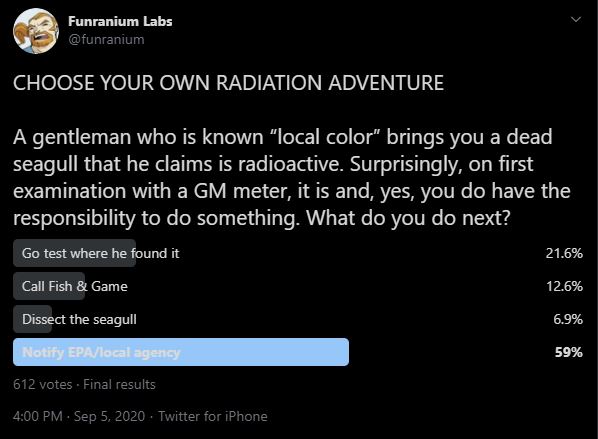The people who work in secured facilities will never know the pleasure of randos walking in off the street to drop things off. Maybe it’s an interesting shaped rock they’re CERTAIN is a dinosaur egg. Maybe it’s a grenade from grandpa’s war chest.
Sometimes it’s a dead bird.
[The first in an ongoing of compiled explainers for my CHOOSE YOUR OWN RADIATION ADVENTURE quizzes. There’s never really a right answer but some might work out better under the constraints of the scenario. It’s like poetry, really.]
As the saying goes “Even a broken clock is right twice a day”, but that only applies to analog clocks where they’re broken such that the hands never move. There’s so many different kinds of clocks, and creative ways to be broken, that this saying makes randos look way more reliable than they are.
In general, the goal of interacting with randos is to get them out of your office/museum/library/clinic as fast as humanely possible, ideally taking their Very Important Contribution To Science & Humanity with them so that you don’t have to call the county hazmat people again. But, sometimes, there seems to be something to what they’re saying or the item is sufficiently bizarre that while it might not be what they imagine it to be it’s worth checking out. And then there’s the times they will JUST. NOT. GO. AWAY.
Many respondents were worried how Local Color *knew* the seagull was radioactive. What? You haven’t met someone in your town that is your local equivalent of Dr. Jacobi that carries their home built “radiation detector” everywhere they go to check everything they buy or eat? Your town is far too normal or you just haven’t met them yet.
PLEASE NOTE: when they tell you that something is “radioactive”, you absolutely do not take their word for it. You doubly do not use their meter confirm their readings. I recommend not even touching it. Also, some folks have some interesting opinions of what is “radioactive”. That meter might actually be for RF or a metal detector. Or both. I have seen some amazing kludged together devices I will describe as INFLUENCE METERS. But rando will claim that anything that makes those needles twitch is radiation. Well, yes, but not in the ionizing sense. So, just because Local Color claims it’s radioactive doesn’t mean they know.
The shocking thing in this scenario is that YOUR meter agrees that there is ionizing radiation present, in a quantity clearly above background. How high above is what helps direct your course of action. If your meter is screaming because of this carcass and going off scale, there’s a damn good chance you have a contamination incident on your hand and it’s time to survey yourself, your desk, and the Local Color for contamination spread and call the EPA while you’re at it.
But one of the tough things here that you can’t answer at first blush is “How did this seagull die?” A screaming meter suggests acute radiation sickness (ARS) but that may not be true. ARS does take some work to achieve. But if there is no sign of contamination, then what? This would suggest that there is a sealed source inside the seagull. This isn’t a good place for a sealed source but, as several of you have noted, seagulls are somewhat indiscriminate about what they’ll shove down their beaks. DO NOT DISSECT IT ON YOUR DESK. Bag it, go to lab.
But if your readings aren’t terribly high, say ~3x times your normal background readings, ARS isn’t the cause of death here unless it was something with a fairly short half-life it rolled around in. So who knows where it even picked up contamination and how long ago before death. But this is still a call because you have an unusual animal death. It might be a first indicator of something weird/bad that’s happened and it just happened to be the least reputable source that brought it to everyone’s attention. Call Fish & Game and they’ll refer you to EPA.
Then he saw a seagull.
Fish & Game got called because security guards watching the video were pretty sure they saw a pervert molesting a large bird. A discussion about which agency has primacy for what ensued as the inspector did his best to assert his right to the potentially radioactive seagull wrapped in his coat and stuck in the back seat of the car. Then the seagull got loose, solving the jurisdictional issues.
The moral is that you should promote interagency cooperation in advance, or you will end up cleaning ever-so-slightly radioactive bird shit out of your vehicle as your sample. And you’ll be known as The Seagull Molester for the rest of your career.
~fin~
